53 Woodworking Projects You Can Sell

Free project plans for woodworking projects that you can sell, no matter your skill level!
You’ve bought a table saw and a few other woodworking essentials.
You’ve finished the projects you wanted to do around the house, and maybe made a few gifts for friends and family.
Now you’re looking at the investment you’ve put in and wondering, “Can I actually earn some money with this?”
The answer is: Yes, but…
Make sure your expectations are realistic.
If you’re just starting out, be sure to give yourself time to refine your technique before you try to sell your work. Your aunt will probably overlook some not-quite-square corners or blotchy stain on the birthday gift you made her. But customers spending their hard-earned money will (rightfully!) expect a certain level of attention to detail.
And while it’s definitely possible to sell furniture and other products, the margins can be slim once you consider your labor. To make a living at it, you’d need to treat it as a full-time job and keep a laser focus on your costs and efficiency. But if your goal is to earn a bit of extra money while enjoying woodworking, you can!
Woodworking Projects That Sell
All of the projects below have free plans or step-by-step instructions. And I think each of them could be sold at a profit. Some might fetch a couple hundred dollars or even more, while others are maybe in the $20-30 range.
Don’t forget that these designs are just a starting point. Once you understand how to build them, you can let your own imagination take over and make them your own. Take a look and see which ones speak to you!
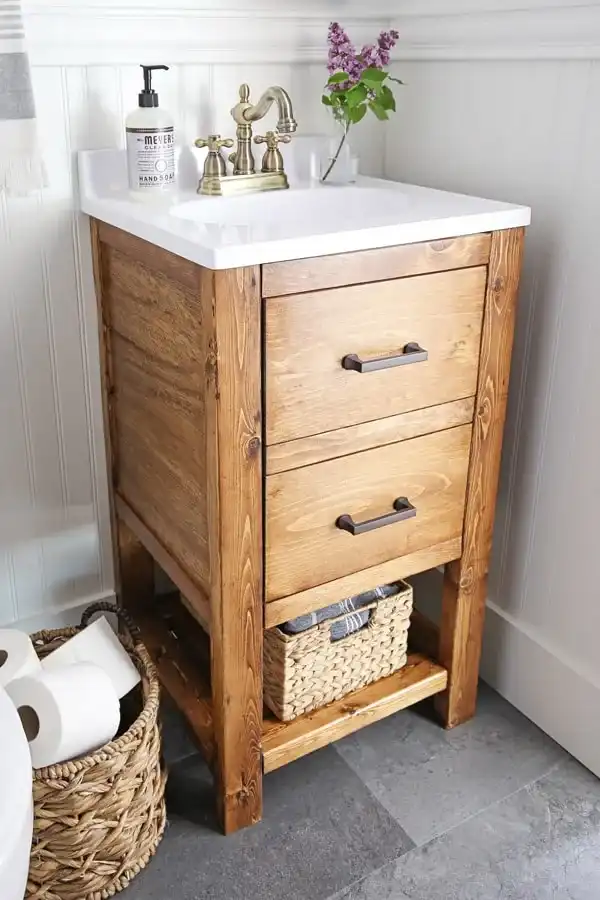
Bathroom Vanity
Bathroom vanities can completely change the look of a bathroom. And they don’t need to be that expensive to build. This project shows how to build a vanity for just $65 in materials. You could easily sell these for quite a bit more than that.
Of course, the vanity needs to be built to match the size of the sink it will support. You could offer different options. An everything-included option could be pre-built include the sink and even faucet hardware. (You probably wouldn’t want to build too many of these, but one can also serve as a demo model if you have a booth or other display space.) For customers who prefer their own specific sink, a custom-built option would only require adjusting a few measurements. These instructions show a hinged door disguised as two drawers, but you could also offer a single-panel door for a cleaner look. And it would be easy to offer a few different finish and hardware options even on the pre-built pieces.
(From Angela Marie Made.)
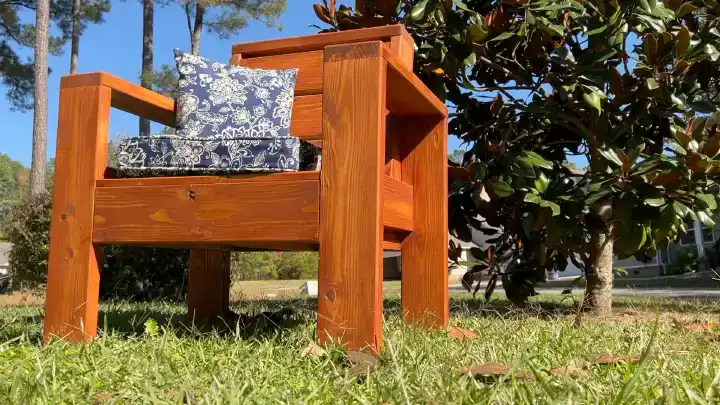
DIY Modern Outdoor Chair
This chair is built entirely from easy-to-source construction lumber. Its designer, Matt, thinks you could sell it for $200 or up depending on the market. I think you could probably bundle it with a cushion for people that don’t want to find their own. While the instructions show this chair with a stain finish, I think it would also look great painted in a bold color (or even a two-tone finish with contrasting arms and seat). You’d probably want to let people select the finish themselves, but you could pre-build a number of these to sell as a set. And make sure that whatever finish you use is suitable for exterior use, since these chairs are bulky enough that most people probably won’t be bringing them inside during inclement weather.
(From 731 Wood Works.)
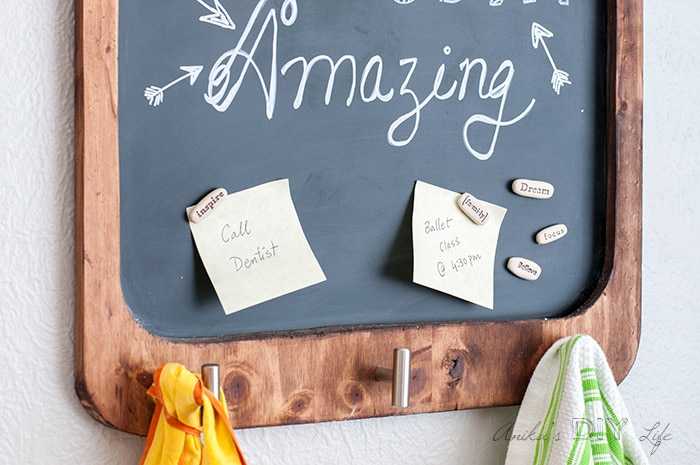
Magnetic Kitchen Chalkboard
A chalkboard in the kitchen or entryway has a couple uses. You could use it to display a personal or inspirational message to family and guests. Or it could be utilitarian, holding shopping lists, to-dos, or other information. As this project shows, even a simple build can produce an attractive, functional product. And, of course, you can modify the size and shape of the wooden frame to your (or your customer’s) heart’s content. I’d probably want to sell these with a (neatly-written) message already on the chalkboard, and bundle a small package of chalk and an eraser, so customers don’t need to do any extra work.
(From Anika's DIY Life.)
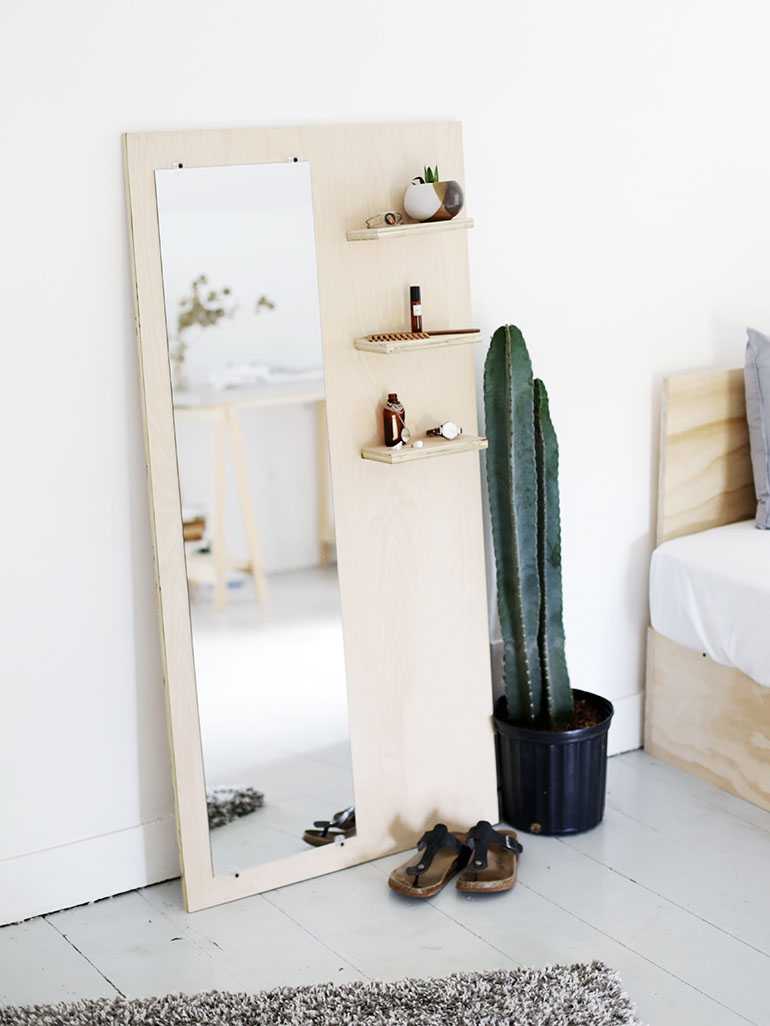
Standing Floor Mirror
Full-length mirrors are a hot item for bathroom decorating. And given that store-bought versions can go for several hundred dollars, a more affordable version might be a big seller. The instructions show this one unfinished, but of course stain or paint could help it blend in to any decor. If you leave it plain, Baltic birch might be a good material to consider. The number, size, and style of shelves can vary to your taste as well. While these instructions don’t show it, I’d suggest attaching a short strap to the back so customers can secure it to the wall (either into a stud or a wall anchor). That’ll help protect against earthquakes, children, or pets that might cause it to slide or topple over.
(From The Merry Thought.)
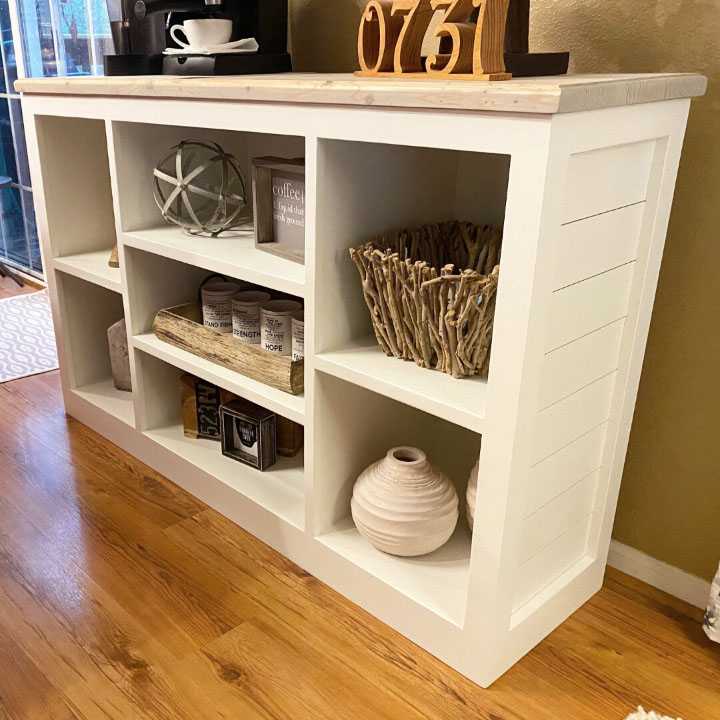
Farmhouse Coffeebar
This is a fairly large piece of furniture, but it isn’t that hard to build. The step-by-step video will walk you through it. Unlike a typical bookcase that’s fairly shallow, this one has a wide top that’s the right height to use as counter space in a kitchen or dining area. Depending on how you want to work, you could offer a few pre-set lengths and shelf arrangements, or let customers tell you exactly what they want. The basic design wouldn’t change, just the measurements.
(From 731 Wood Works.)
Device Charging Station
Almost everyone’s home these days has at least one countertop full of chargers and cables. A charging station like this helps hide some of the unsightly mess, and gives each cable a home so you don’t need to dig it out of a pile every time. The video uses plywood, but I’d consider using a little nicer wood–maple or walnut might look nice. Of course, plywood will work, too, but if you go that route, I’d be sure to include the edge banding as the video demonstrates, to give it a more polished look.
(From Woodworking for Mere Mortals.)
Trivet Set
Every woodworker ends up with pieces of scrap wood that seem like a real waste to just discard. This project is a great use for some of that scrap wood. These trivets are both attractive and functional. I think you’d have no problem selling them either individually or as a set of three. The video shows the use of a planer and a router. But I think you could make just as nice a set using a jigsaw and sander, maybe without the “cut out” portion on the bottom. And you can make whatever sizes lets you get the most of the lengths of scrap in your shop.
(From Crossman Designs.)
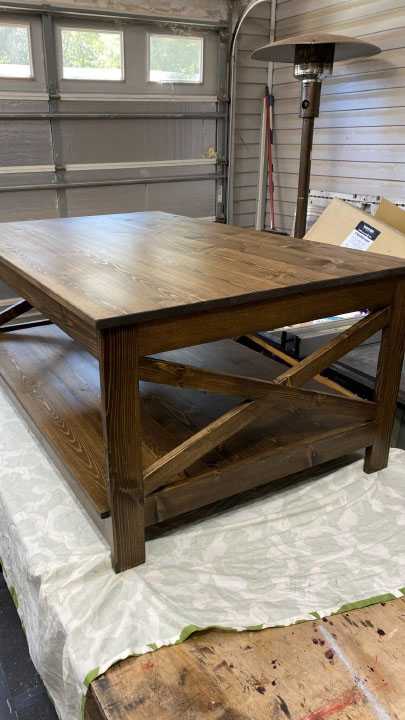
DIY Farmhouse Coffee Table
While this project is large, it comes together fairly quickly thanks to the use of pocket holes. Now, I know some people look askance at pocket holes compared to more traditional mortise-and-tenon joinery in a project like this. I think it’s totally up to you and your customers to decide. The creator of these instructions gets $350 for these tables that take about two days to build. You might not turn it into a full-time job, but that’s a pretty good return for a weekend’s work!
(From 731 Wood Works.)

Jumbo Tic-Tac-Toe
Oversized games are a surefire hit at parties and barbecues, both with adults and their kids. This one is very easy to make and can be decorated however you want. It just uses standard “two-by” lumber, which you probably already have scraps of lying around. You could easily bust out a bunch of these in one afternoon and sell them over the summer at markets or craft fairs.
(From Gingersnap Crafts.)
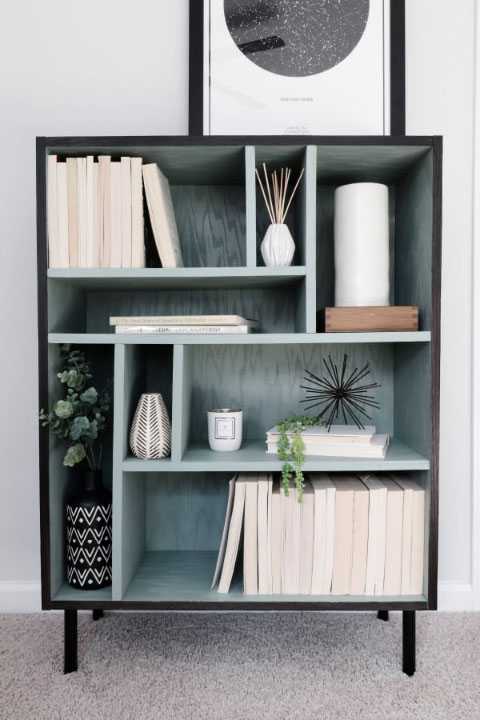
DIY Bookshelf
Aside from being a cool-looking bookshelf, I like the finish idea presented here. Rather than choosing between a natural stain or a colorful paint job, you can get both! The colored stain used here still lets some of the wood grain show through. You could use this same approach on any number of the other projects listed here. Or this bookshelf would look great with a solid paint scheme too.
(From Crafted by the Hunts.)
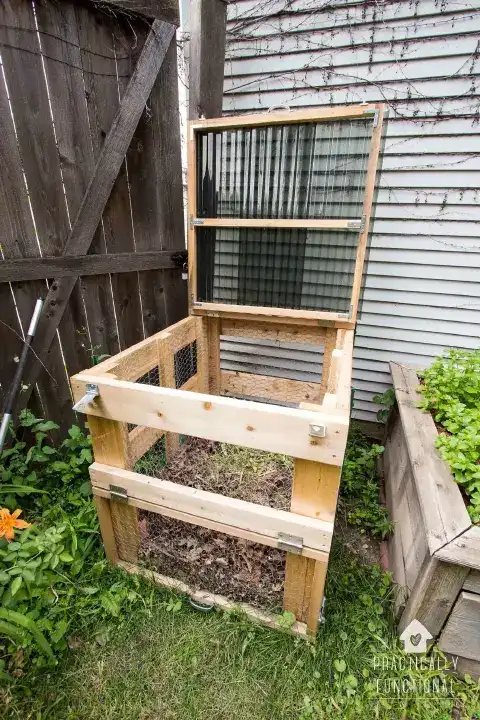
Covered Compost Bin
Composting keeps getting more popular as people step up their efforts to reduce waste. Some people live in municipalities that take care of composting, but many don’t. Or they want to keep the compost for their own lawn or garden. And not everyone has the skills or tools to build a bin like this that keeps nosy pets and kids out of the compost pile. You can probably sell these pretty, especially in suburban areas where residents have the yard space to dedicate to it. Maybe include some instructions on how to get the best results from composting, to save your customers the trouble of searching.
(From Practically Functional.)
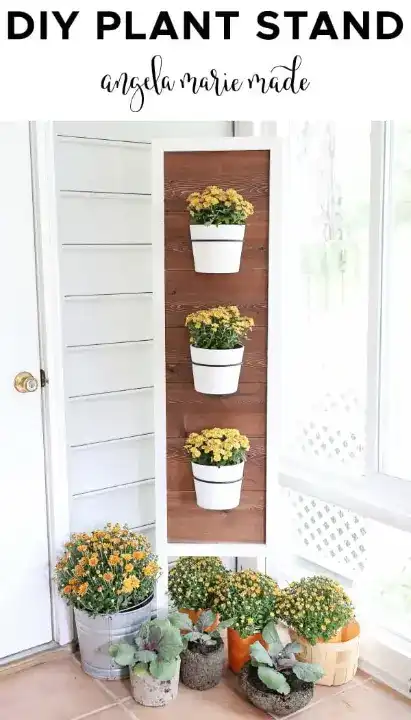
Vertical Planter Stand
Flowers and plants can improve the atmosphere (literally!) of almost any space. But there’s not always a spot to put them that keeps them safe from being knocked over or trampled on. This clever upright stand lets people show off their green thumb just about anywhere. It can be tucked into just about any corner, and could also be an easy way to camouflage any messy or unsightly clutter
(From Angela Marie Made.)
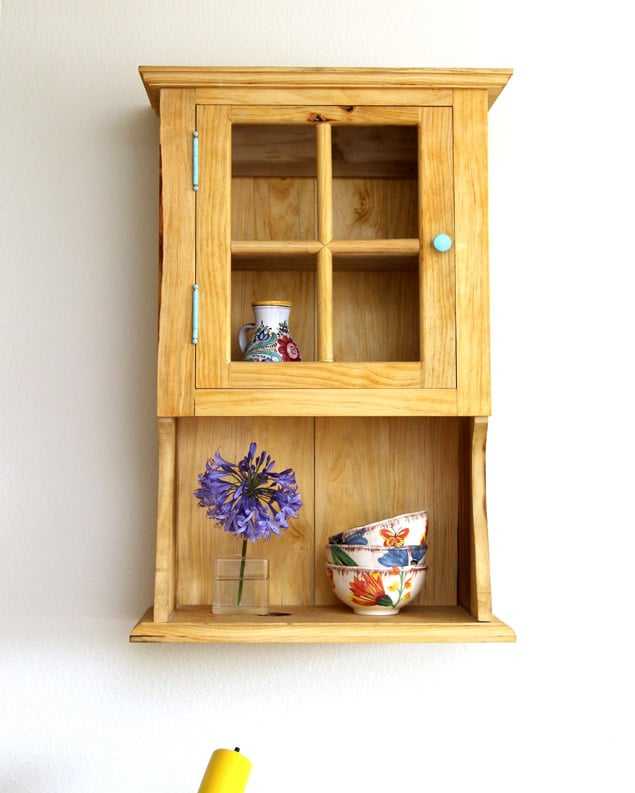
Wall Cabinet
Wall cabinets like this one do double duty. They provide some extra storage space while also providing visual interest on a wall that needs it. This design definitely has a farmhouse aesthetic to it, but I think you could tweak it to offer more options. Leaving off the trim moulding around the edges and the door, for instance, would give it cleaner lines for a more modern look. Or use different wood like oak or walnut to produce different vibes.
(From A Piece of Rainbow.)
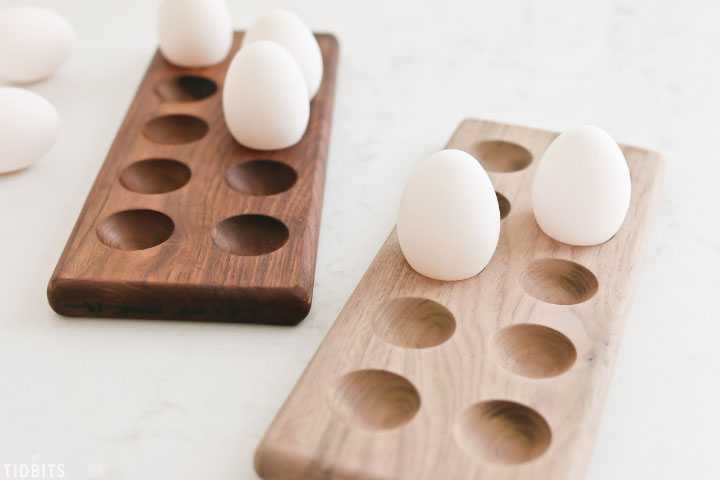
Wooden Egg Holders
An egg holder might not top everyone’s list of must-have kitchen accessories. But there’s certainly still a market for more specialty items like this, even if it’s only busted out to serve deviled eggs at a party! Plus it’s really straightforward to make out of scrap wood, so you could spend a couple hours and crank out a few of them whenever the scrap pile threatens to take over your shop.
(From TIDBITS.)
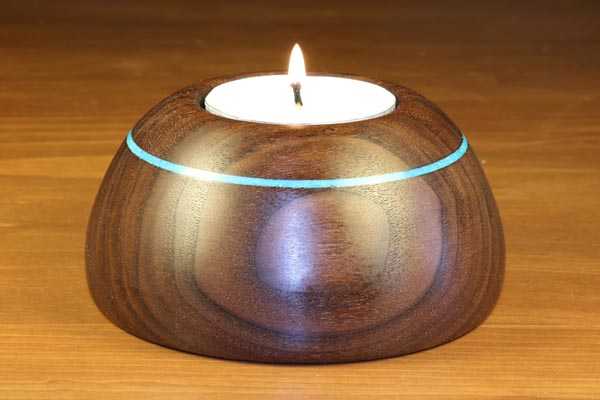
Candle Holders
These beautiful candle holders have an inlaid turquoise band, though they’d still be very attractive even without it. You’ll need a lathe to make them, so they do require a bit more equipment than most of the other projects I’ve listed. A lathe is certainly not required to make money selling woodworking projects. But I think this project demonstrates that investing in one opens up a whole new category of products you can make!
(From SunCatcher Studio.)
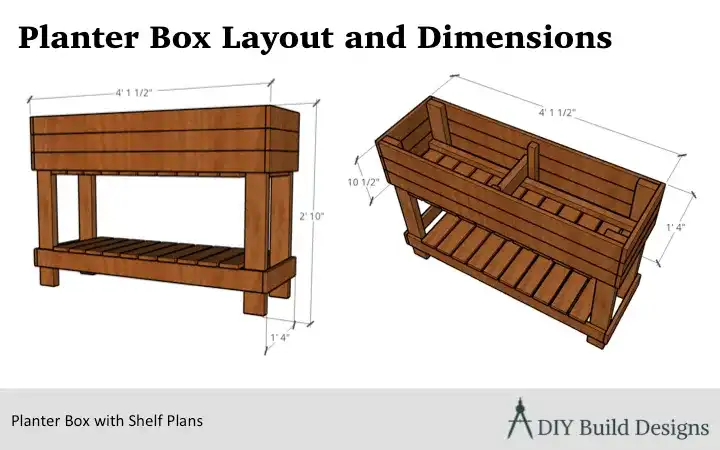
Planter Box with Legs
Gardeners will love this elevated planter box made from cedar. And if you’re making these to sell, you’ll appreciate how the plans minimize the waste from 8’ cedar boards. You could, of course, alter the dimensions if your customers want custom sizes. But it might be smart to tack on a customization charge to account for the fact that you’ll possibly require more lumber than the “optimized” size requires.
(From Crafted Dollar.)
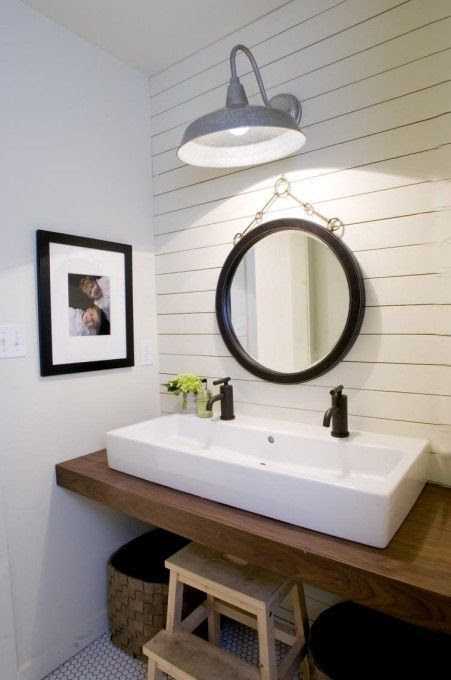
Modern Wall Vanity
This vanity a bit more of a specialized piece. Not every bathroom will be configured in a way that you could install this kind of vanity. And it’ll clearly need to be custom-made to fit in a specific space. So it’s not something you’d build and try to sell at a market, but you could include it in a portfolio of custom pieces you can make to order. It’s actually pretty easy to build, and the result is something quite different from your typical bathroom vanity.
(From More Like Home.)
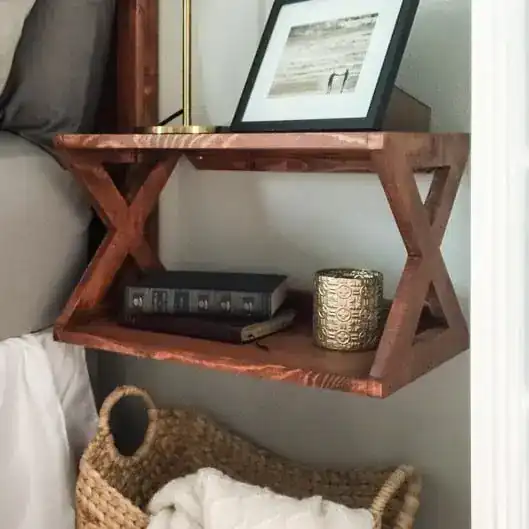
DIY Floating Side Tables
I have to admit, the idea of a floating nightstand rather than a standard floor-standing one never even occurred to me until I saw this project. It’s great because it leaves space underneath for additional storage, or you can leave that space empty to give the bedroom a little lighter feel. Obviously this project requires some installation work. You could either provide detailed instructions and the needed hardware as part of the purchase, or offer your own installation service if you’re so inclined.
(From Joyful Derivatives.)
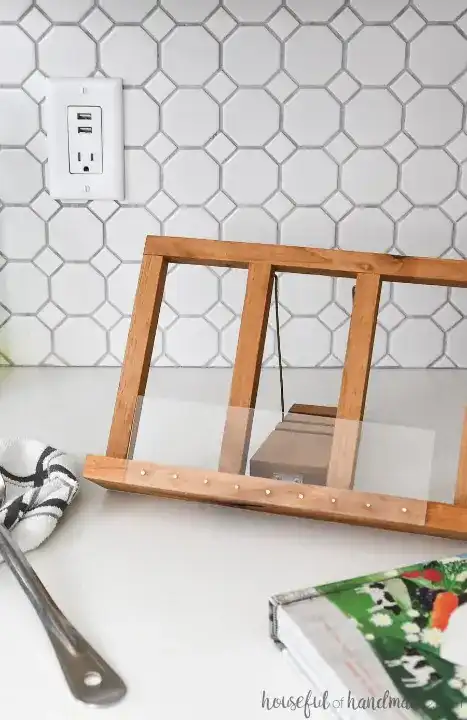
Easy to Build DIY Cookbook Stand
This stand is quite easy to make and has a nice, sleek look. It’s meant to hold a cookbook but could also be used decoratively, to display an art book or other coffee table book. I’d imagine you could make several of these at a time, and maybe even partner with a local market or bookstore to sell them in their cookbook section.
(From Houseful of Handmade.)
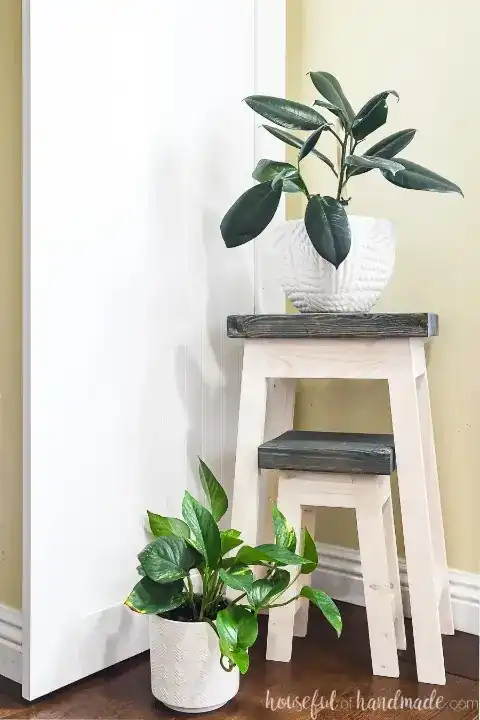
Nesting Plant Stands
Another take on plant stands is this set of nesting wooden stands. Putting plants at different heights in a room helps provide some visual interest. You could do that with two different stands, of course. But the fact that these two are designed to nest together gives some additional options. Letting the smaller one hide under the taller one, protruding just enough to hold a plant, is a little more interesting than just putting two stands next to each other. Of course, you could sell them individually, too, but I think selling them as a set is what would set this project apart.
(From Houseful of Handmade.)
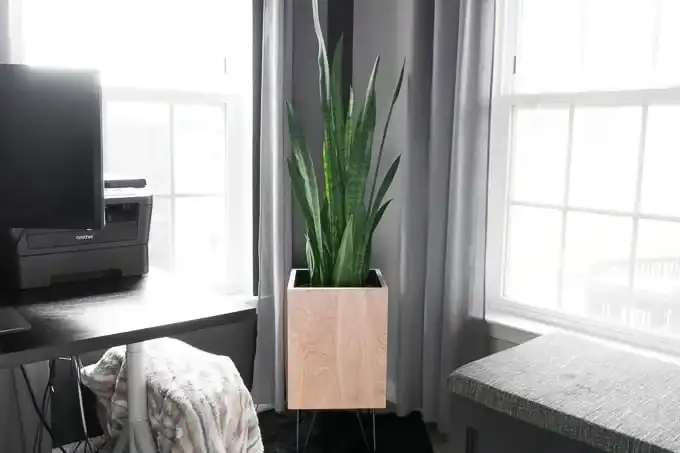
Modern Plywood Planter
The hairpin legs on this planter give it a cool retro look. Buying the legs as a kit is an easy way to add this design touch to any project. Although this planter is made of plywood, not all plywoods are equal. You’ll definitely want to use a higher quality plywood than you might use for general construction. And a high tooth-count table saw blade will do a better job of making smooth cuts without chip-out than your stock blade that came with the saw.
(From By Brittany Goldwyn.)
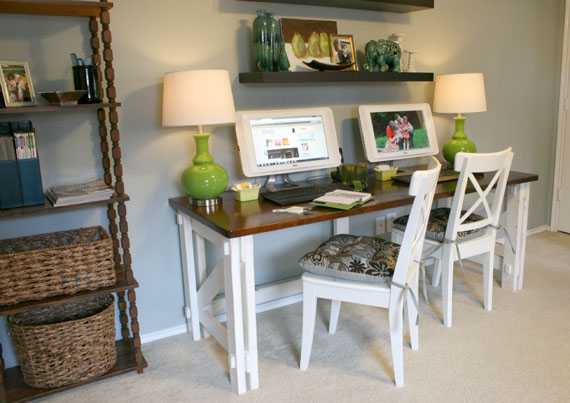
Computer Desk
So many people are looking to upgrade their home offices as remote and hybrid work becomes more normal. Custom pieces like this one provide a little more personality than mass-market furniture. It may not be practical for you to pre-build a piece this size unless you have the space to store and display it. But if you could use it yourself, or you have a friend or family member who could, take pictures to market it on your website or social media.
(From Remodelaholic.)
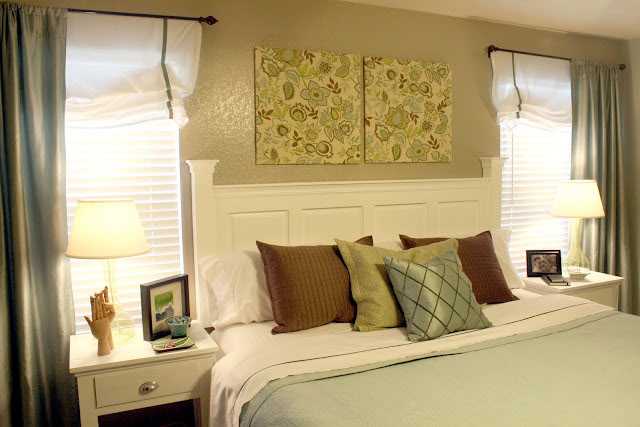
Head of the Board Headboard
This is a clever way to repurpose old cabinet doors to make a stylish headboard. You can probably find a steady supply of old doors at your local salvage/reuse center. Of course they won’t always be the same size or style, but as long as you get enough of a set, you can tweak the plans to fit. Keep a few on hand so you can fulfill requests for the headboard, since it would stink to have to turn down an order just because you couldn’t find any at the time.
(From Remodelaholic.)
Modern Console Table
I love the contrast between the white oak and the walnut in this sleek console table! Of course, you could make the whole thing out of the same wood for a little more low-key look. The video walks you through building this piece, which I think rivals what you could find in a furniture store. You shouldn’t have any problem selling a piece like this that’s both beautiful and functional.
(From Timber Biscuit Woodworks.)
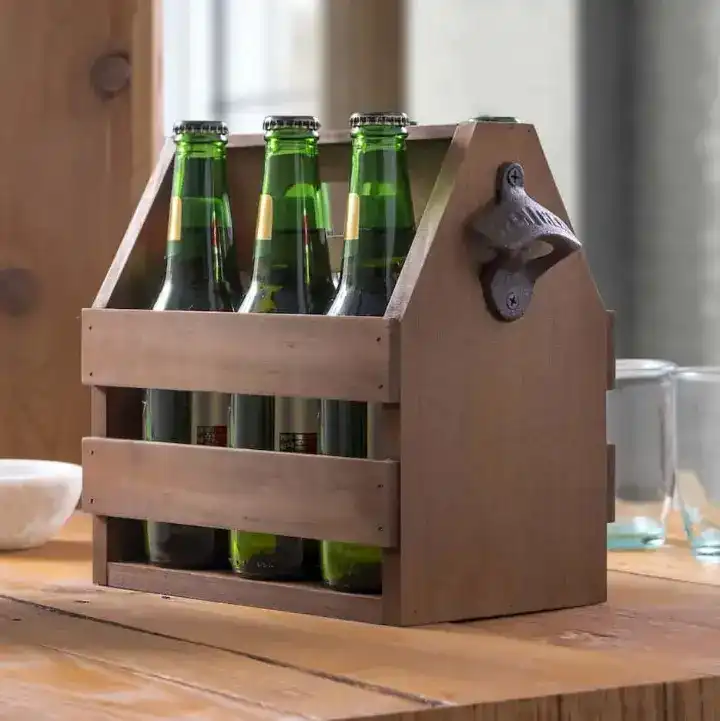
Make a Wooden Beer Caddy
Small items like this are simple to make, so you could turn out quite a few of them in a short time. Obviously you won’t get a huge price for each one, but that doesn’t mean you can’t make some money. With a wood-burning kit or some simple nameplates, I think you could partner with local small businesses like microbreweries, soda makers, and so forth.
(From DIY Candy.)
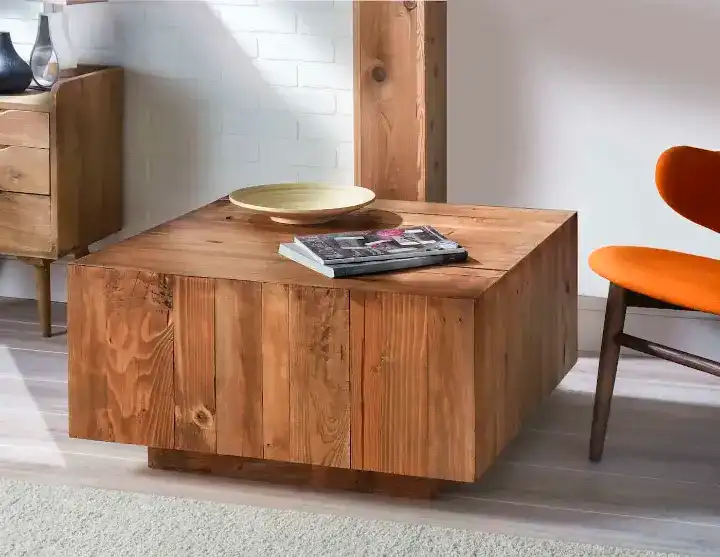
DIY Coffee Table
This is a great example of how you can produce furniture just as stylish as a major chain like West Elm at a fraction of the price. In this case, they used reclaimed pallet material to save even more money. Even after your costs and labor, you could sell this for far less than the store version. It has the same look, but you could offer even more customization when it comes to the size and finish.
(From DIY Candy.)
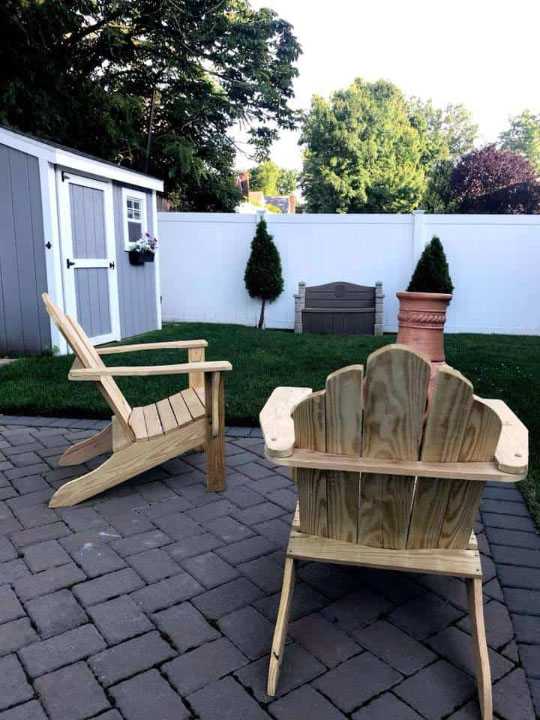
Adirondack Chairs
Adirondack chairs have been a popular outdoor seating choice for decades. While they’re certainly available at furniture stores or garden centers, they’re also well within the capabilities of almost anyone with a few tools. By offering a variety of finishes, you can differentiate yourself from the mass-market options.
(From Just the Woods.)
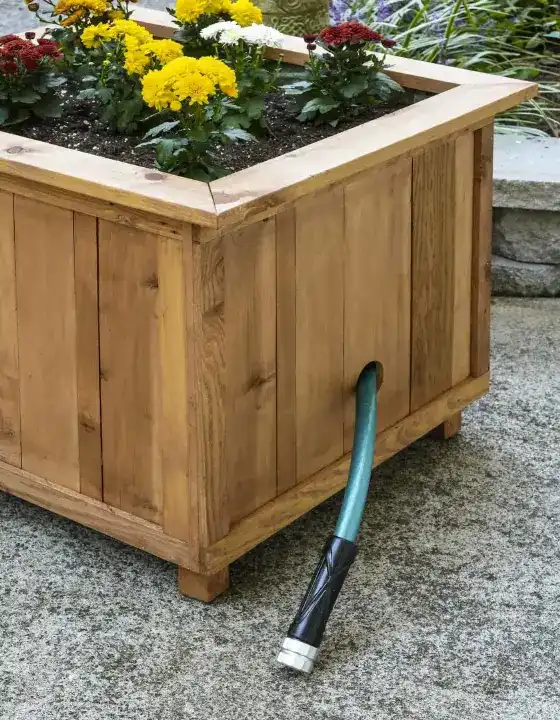
DIY Hose Holder
Here’s one on my own to-do list! This is a simple design that pulls double duty. You get a nice flower planter that also provides a secret compartment to hold your garden hose. Perfect for keeping the hose handy to where you need it, but still keeping it out of sight. Projects like these are easy to build, but not everyone has the skills or tools to do it. So consider partnering with local garden centers or nurseries to sell these on consignment.
(From DIY Candy.)
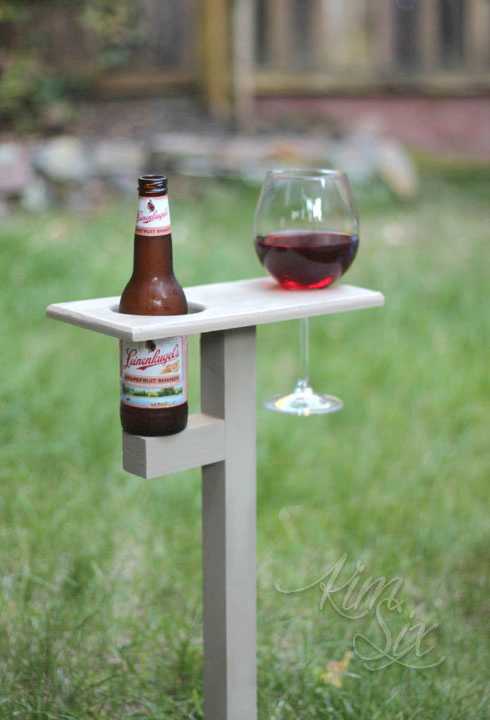
DIY Outdoor Drink Stakes
One of the simplest projects in our whole roundup, but one of the handiest. You can easily make these out of scraps if you only need a few, or you could make a bunch of them out of fairly affordable material if you have a larger order. You probably want to sell these in sets of two or four, since they’re geared more towards outdoor parties or other social events. They lend themselves to being branded, so you could probably partner with local breweries or wineries to sell them in their gift shop. Of course, you won’t get big money for them, but they could provide a nice little income stream for not much effort.
(From The Kim Six Fix.)
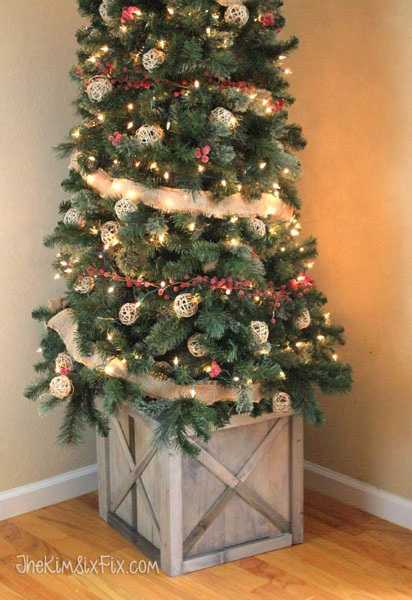
DIY Scrap Wood Crate Christmas Tree Stand
Christmas-related items are always popular, and this tree stand can be made entirely from scrap or recycled wood. Though of course there’s nothing stopping you from using new lumber if you prefer. You don’t need to stop at just Christmas, though, as you could market this as a decorative item year-round.
(From The Kim Six Fix.)
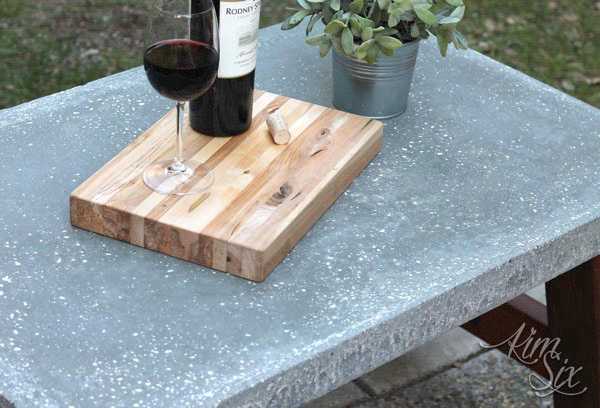
Pottery Barn Inspired Concrete Top Coffee Table
Another great example of how you can replicate a popular piece of furniture for far less. This one goes beyond just woodworking to include a concrete top, but the steps are still straightforward enough for anyone with some basic skills. And of course you can offer more customizations than the big chain retailer is able to, once you have the basic deisgn down. And the concrete provides a whole other avenue for giving it your own twist, since there are a number of different treatments you can apply to it.
(From The Kim Six Fix.)
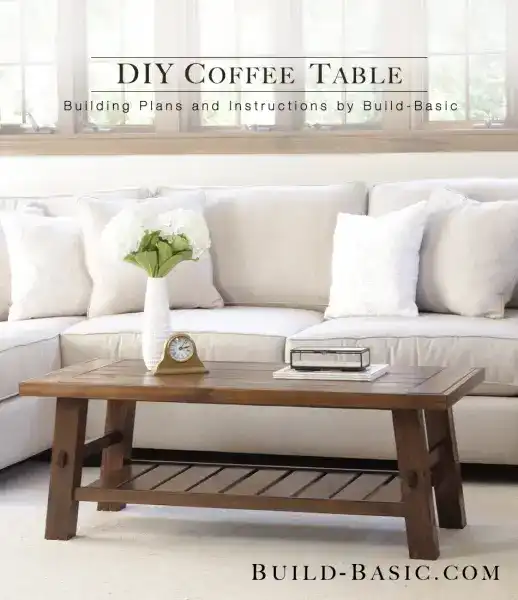
How to Build a Coffee Table
This coffee table looks like it’s out of a furniture catalog, but it’s actually pretty easy to build yourself. This design cheats a little bit, giving the impression of mortise-and-tenon joinery without actually requiring any. Of course, if you’ve got the skills for that kind of joinery, by all means you should go that route! But the steps in this project are easy enough for anyone with basic woodwkring skills to tackle it.
(From Build-Basic.)
DIY Console Table
Console tables like this one don’t have to be that complicated to be useful. Whether it’s in a hallway, behind a sofa, or anywhere else, they give a room some visual interest and let you show off even more decorations. The video shows using nails to construct it, but I think some of the commenters have a good idea to make it a little sturdier using screws.
(From The Rehab Life.)
Industrial Shelving Unit
Industrial-looking furniture continues to be a popular decorating trend, both for residences as well as small businesses. This shelving unit requires only some basic techniques, but the result is quite striking. The video shows how to distress new wood, but of course if you happen to already have some reclaimed wood, you can skip that step. If you have a permanent spot to display them, you could even use them to display other products while you wait for a sale.
(From The Rehab Life.)
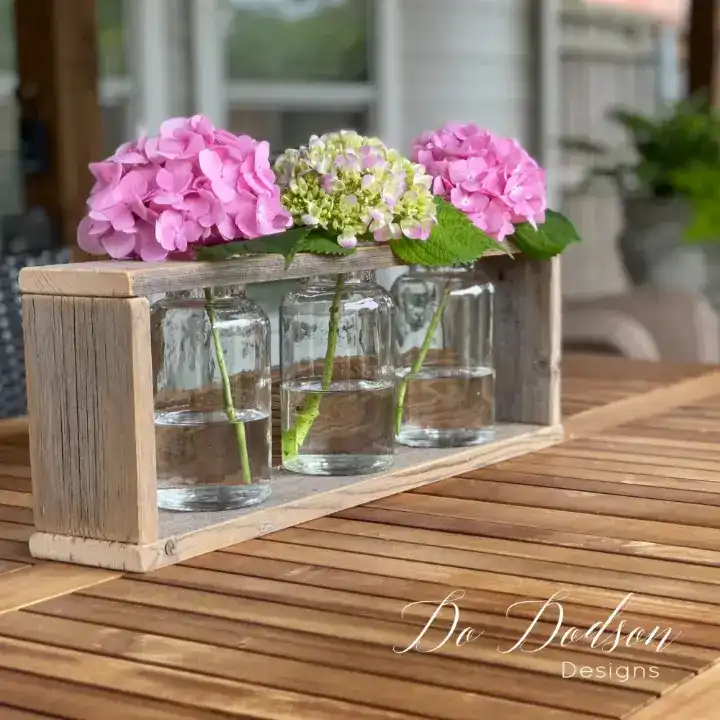
DIY Wood Vase Holder
Nothing too fancy with this project. It uses some reclaimed wood to fashion a simple vase holder with a rustic look. You could use the same design to make it out of any wood you choose, of course. I’d probably try to sell this as a bundle with some vases that are guaranteed to fit, just to reduce the hassle for the purchaser.
(From Do Dodson Design.)
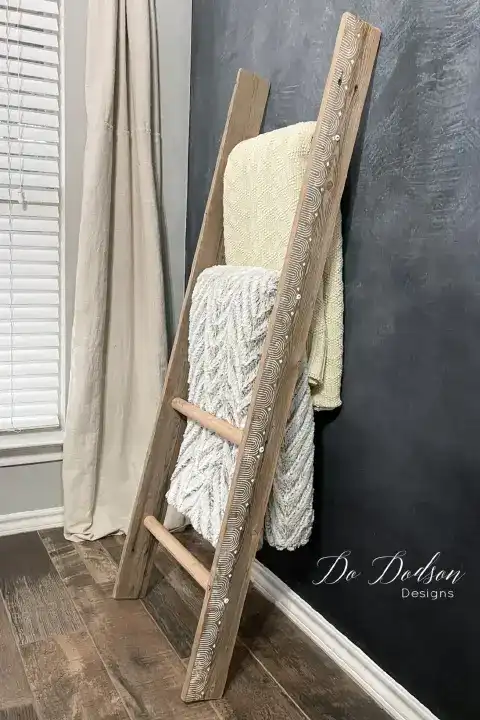
DIY Rustic Blanket Ladder
Reclaimed wood is a perfect material for rustic-looking projects like this one. It’s a very straightforward build, but it’s perfect for what it does. Blankets and quilts are often heirlooms with sentimental value to their owners. A blanket ladder shows them off while still keeping them close at hand.
(From Do Dodson Design.)
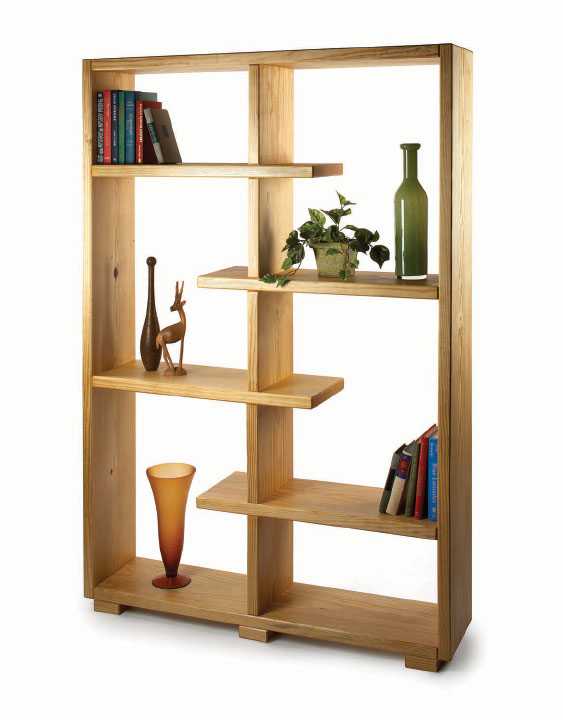
Contemporary Shelves
It’s really hard to believe this sleek-looking shelving unit is made from nothing but construction-grade lumber! It just goes to show that, with the right design and finish, you don’t need to spend a fortune on materials to produce a great piece of furniture. Since this unit is open on both sides, it would function well standalone or as a room divider. For use against a wall, consider including a small earthquake strap that the customer can attach to a stud or wall anchor for extra safety.
(From Popular Woodworking.)
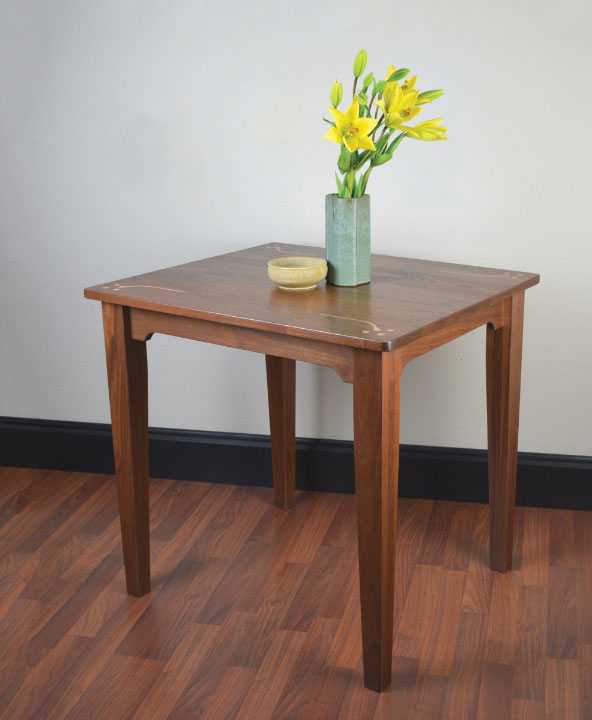
Weekend Walnut Table
Walnut is my favorite wood, and a lot of other people’s as well. This is nice, simple table design that lets you exercise some more serious woodworking skills. It uses mortise-and-tenon joinery as well as some router templates to produce the decorative inlay on top. If you don’t have a router, you can certainly skip the inlay step, as the table will look just fine without it. But if you do have a router, you can really let your imagination guide you for the inlay, using these instructions as a jumping-off point.
(From Popular Woodworking.)
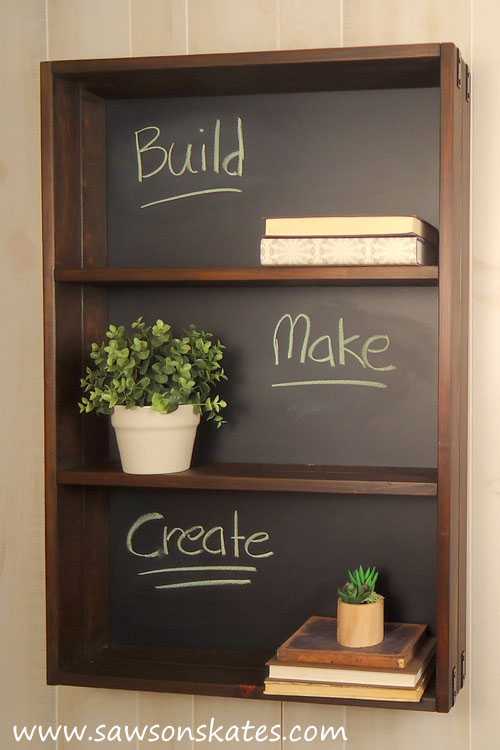
DIY Knockoff Chalkboard Shelf
This is a really cool wall-mounted shelving unit. The chalkboard back is a clever idea that lets you express yourself with words in addition to whatever decorative objects you want to show off. The metal brackets are an interesting detail that helps give the piece even more character. You can sell this for less than the furniture-store version it’s based on, even after accounting for materials and labor.
(From Saws on Skates.)
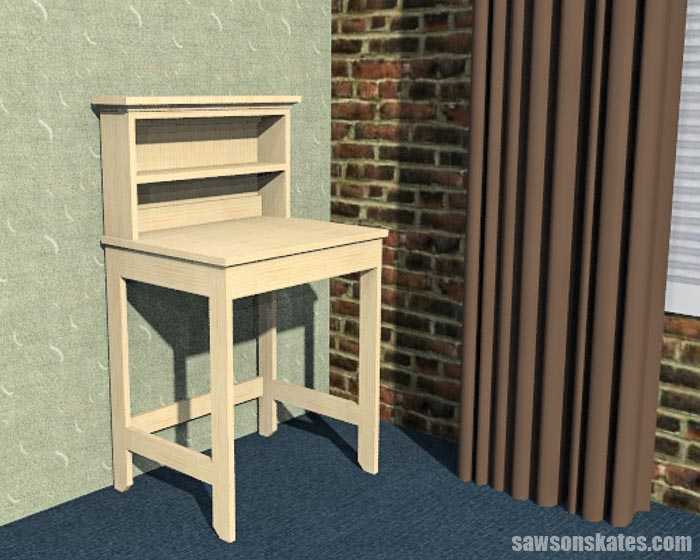
DIY Writing Desk with Storage
The design of this writing desk is pretty simple, but there’s room for you to customize it through the choice of wood and finish. The construction relies mostly on pocket holes rather than fancier joinery. Depending on your skill level, you may view this as a plus or a minus. But it definitely makes this project accessible for just about anyone!
(From Saws on Skates.)
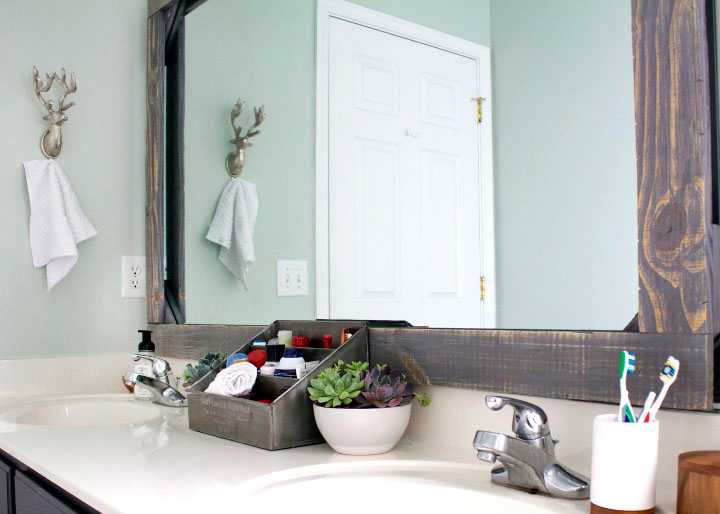
Rustic Mirror Frame
Once you know how to build a rustic frame like this, you could sell it a couple different ways. You could sell it with a mirror already installed, in preset sizes. Or you could do custom orders for people with “naked” mirrors they’d like to have framed. In that case, it would be up to you to decide whether to let the owners mount the mirror themselves or offer to install it.
(From Tag & Tibby.)
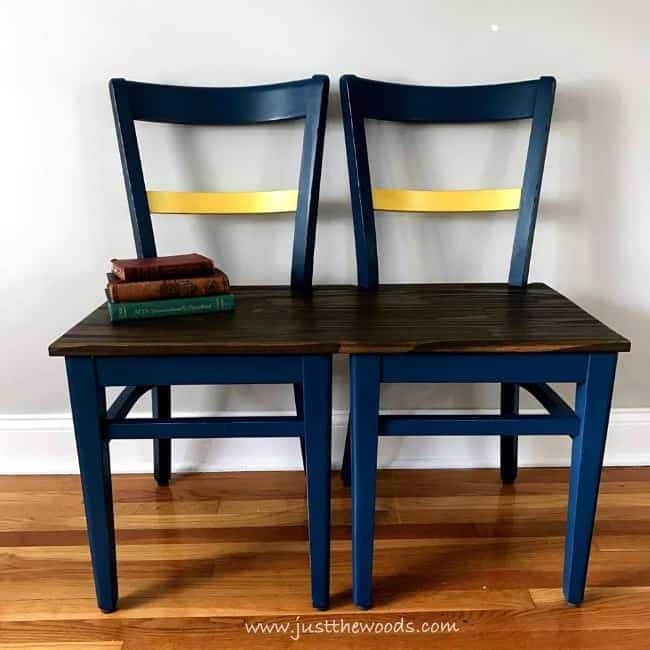
Bench Made From Chairs
This is a very clever way to repurpose chairs that have seen better days. By salvaging the chair frames, you have the makings of a very unique bench for an entryway or porch. It’s a look you won’t find in the big furniture stores, and it’s sure to draw comments. You can often find sets of beaten-up chairs at salvage or reuse stores, or even at restaurant auctions.
(From Just the Woods.)
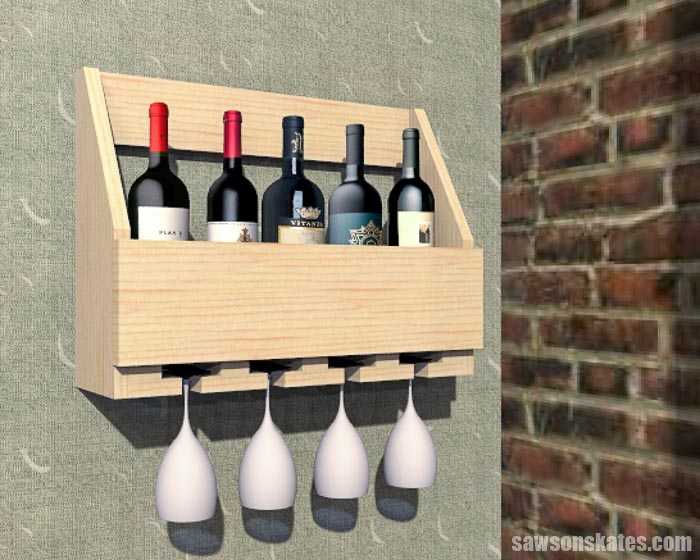
DIY Wall Mounted Wine Rack
A fun little project that can be built from scrap wood if you prefer. It’s got space for a few wine bottles in addition to four stemmed glasses. This might not be for everyone, but folks with a home bar nook would appreciate this! As I mentioned with some other projects, I think you could knock out a number of these and partner with local wineries or even wine shops to sell on a consignment basis.
(From Saws on Skates.)
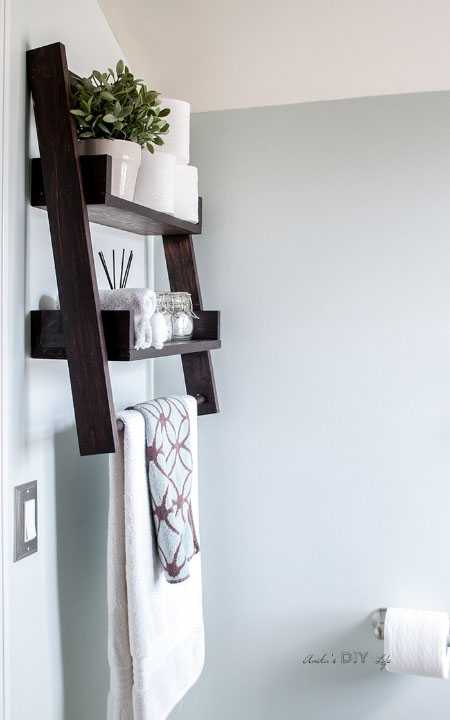
DIY Floating Ladder Shelf
As the creator points out, this combines two different trends into one idea–ladder shelves and floating shelves. Floating shelves are nice because they don’t take up any floor space, leaving that area free for other furniture or decor. This is a little more stylish than many floating shelf units. The shelves and sides protrude out to give the impression of a ladder leaning against the wall. It’s pretty easy to build, and the material won’t set you back that much either. You might want to bundle this with some instructions on how to hang it, and include the 3” screws so customers aren’t tempted to use smaller screws with less holding power.
(From Anika's DIY Life.)
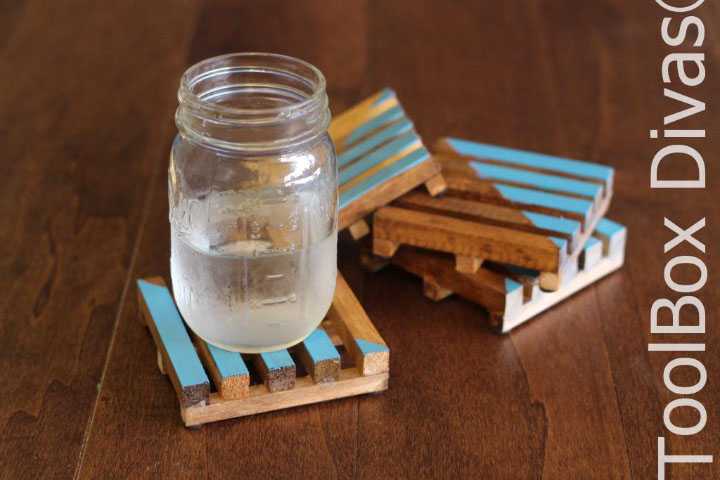
Easy DIY Pallet Coasters
There are tons of project ideas out there that reclaim wood from pallets. This project actually makes new pallets! Granted, they’re tiny, coaster-sized pallets… I think this is a clever little design, and easy to make. Where you can really make them interesting is in the finish, since they have such a strong geometric quality. You won’t make a living off of small items like these, but they make a great “impulse item” to sell alongside your larger pieces.
(From Tooldbox Divas.)
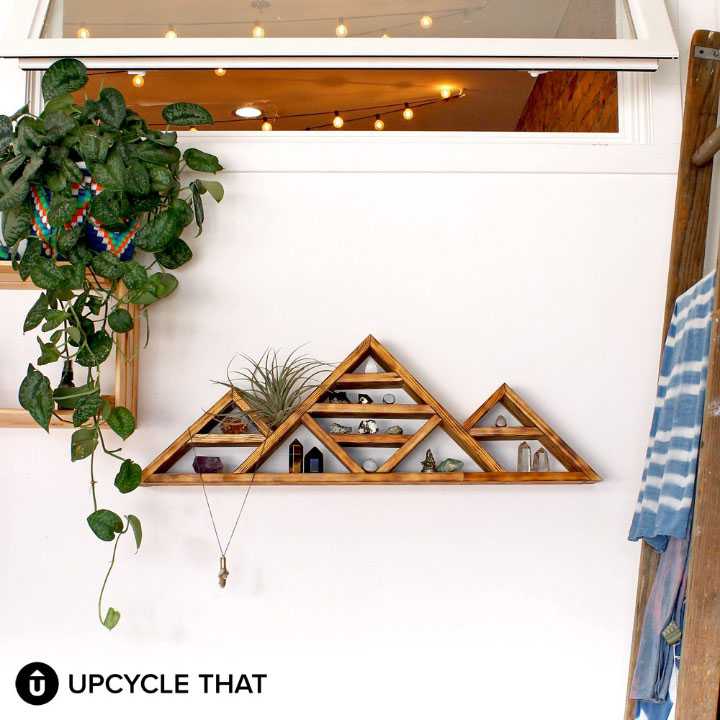
Mountain Shelf
The triangular shapes in this shelving unit really make it pop against a wall. It looks complicated to make, but the step-by-step instructions show that it’s really not hard at all. While you could put any finish you want on the shelf, the instructions also show how you can use a blowtorch to give it a really deep, aged look. Once you get the technique down, you can use it on all sorts of projects to give them a bit of a twist!
(From Upcycle That.)
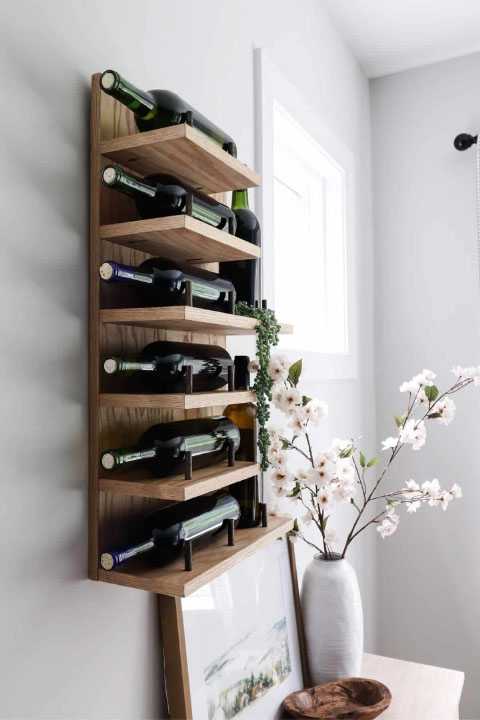
Easiest DIY Wood Wine Rack
This variation on a wall-mounted wine rack is made from plywood, but the use of edge banding makes it look like solid wood. Of course, you could make it out of solid wood too, but you’d need to adjust your asking price accordingly. The simple geometry of this piece is a nice way to frame the wine bottles themselves.
(From Crafted by the Hunts.)
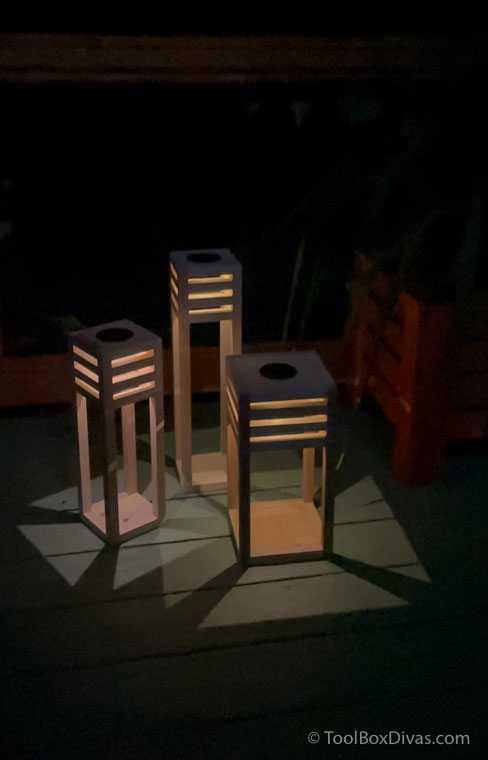
Set of Solar Lanterns
Lanterns are a popular way to light outdoor spaces for parties or barbecues. These rely on solar-powered lights, so they don’t require batteries or open flames! A few different sizes are shown in the design, and the design is simple enough to customize to whatever size you desire. You can stain these if you want, but I think they’d also work great with some bright colors. You could probably sell these in sets of 3, either all of the same size or one in each size like the project page describes.
(From Tooldbox Divas.)
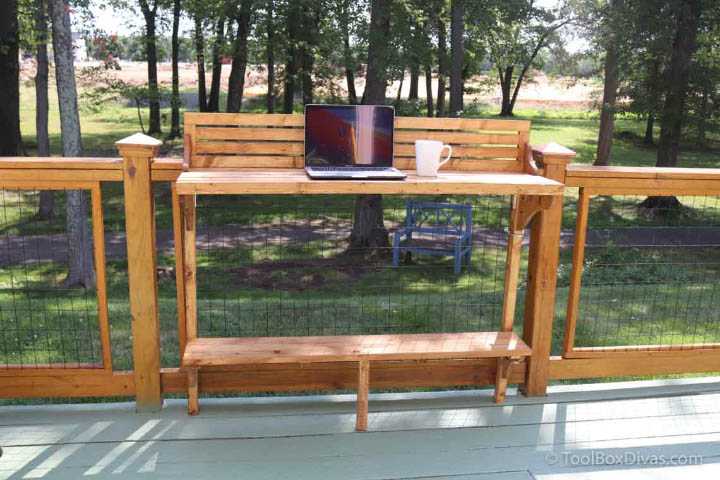
Balcony Bar Table
Balconies and patios are always a great place to entertain guests, but there’s not always a lot of free space to set up extra furniture. This bar table is a very interesting solution to that problem. It’s removable, so you can take it down when it’s just you and your family using the space. And it quickly attaches to a railing or fence when you need the extra table space for entertaining. Make sure to include the mounting hardware with the finished product!
(From Tooldbox Divas.)
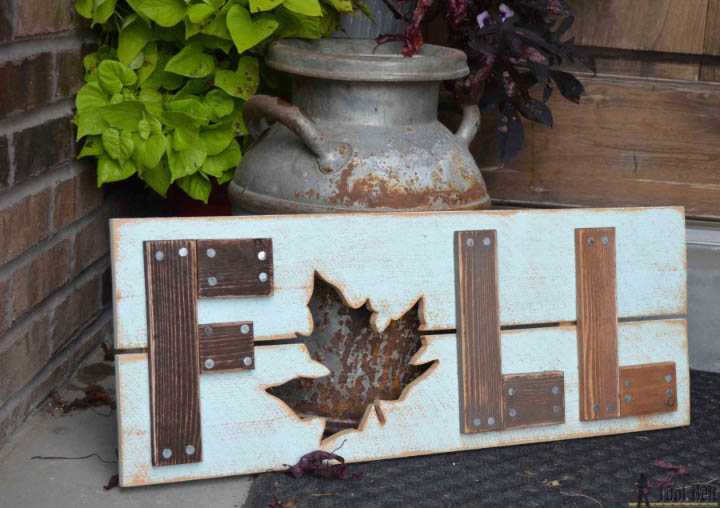
Wooden Fall Sign
Signs with short messages like this have been a popular decorating trend for years. This one adds some sophistication with the “A” being replaced by a leaf-shaped cutout. You could certainly envision other messages with this same basic design, too. It might take a little brainstorming to figure out the right shapes for both the letters and the cutouts, but the basic technique will be the same in any case.
(From Her Toolbelt.)
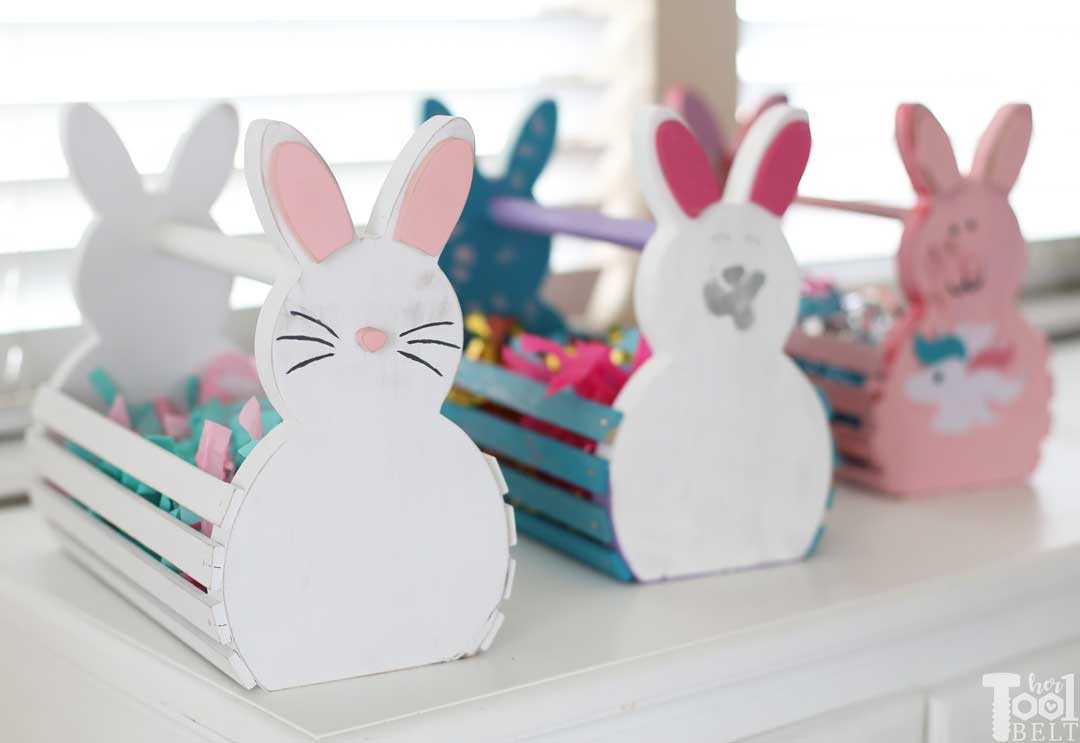
Wood Bunny Easter Basket
Holiday themes are always big sellers, though naturally they are seasonal rather than year-round. I like this project because it’s simple enough that anyone with some basic tools can make it. And while the Easter bunny theme seems like it might be limiting, you could take this same basic concept and adapt it to just about any holiday! All you need is the right pattern to cut the end piees.
(From Her Toolbelt.)
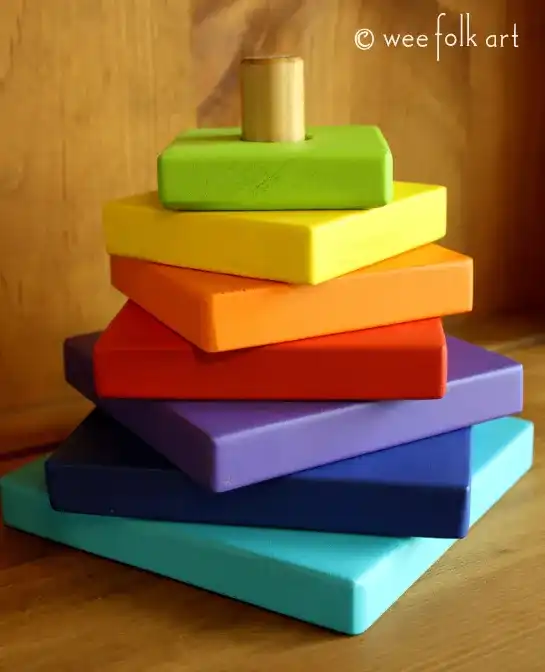
Wooden Stacking Toy
An easy project for anyone with basic tools, this is a fun little toy for young kids. Just make sure that you round off all the edges and corners with sandpaper or a router, to avoid sharp corners. And you’ll also want to use a non-toxic finish.
(From Wee Folk Art.)
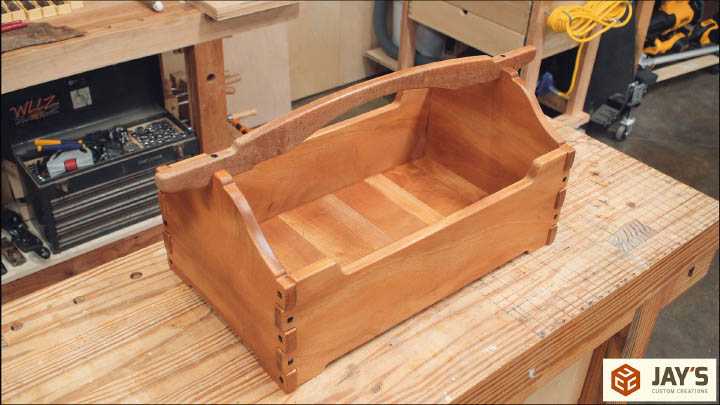
Greene and Greene Tool Tote
Detailed step-by-step instructions ensure your success when building this really cool Arts & Crafts-style tool tote. You’ll probably want to build one for yourself first! But a quality item like this will sell, too. Whether it’s at a craft fair or through your local hardware store, people looking for something more unique than your typical mass-produced toolbox will appreciate the work that went into this one.
(From Jays Custom Creations.)